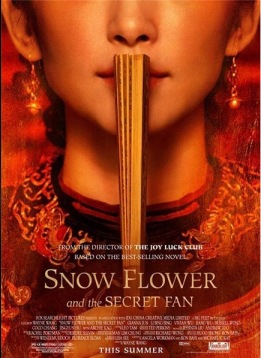
SNOW FLOWER AND THE SECRET FAN
China, 2011, 120 minutes, Colour.
Bingbing Li, Ji-hyun Jun.
Directed by Wayne Wang.
A fascinating visit to China, present and past. Readers of the book by Lisa See have commented that the film focuses on the past and that the film has created the story set in the present. This makes it a different interpretation of the book and highlights the comparisons between the 21st century and the early decades of the 19th century. This is particularly the case in the status and treatment of women. This is very much a woman’s film in focus, themes and performance.
Hong Kong born Wayne Wang has had a very varied career for over twenty five years. Some of his earlier films from the 1980s had Chinese themes (Dim Sum, Eat a Bowl of Tea) some of them in an American setting. After that, he made many films in the US, with very American themes (Smoke, Maid in Manhattan). However, in recent years he has shown a greater interest in Chinese stories.
One of Wang’s best-known film is The Joy Luck Club (1993), the story of four Chinese women, their past in China and their lives in America. Snow Flower can be seen as a companion piece. But, the story remains in China with only verbal references to the US and to Australia.
The film opens in the present in contemporary Shanghai. It should be said that the views of Shanghai throughout the film are very striking. We get a very good look, in close-up, of how Shanghai is a modern and developing city. We are introduced to Nina, a young woman about to open a New York office of her bank. But, she receives news that her close friend, Sophia, is in coma after a bicycle accident.
Flashbacks are introduced to show how the two girls met. Nina coaches the Korean born Sophia in Mandarin. So, we are offered two times as the film moves between the present and the past of the two women, especially the formalising of ‘laotong’, a lifelong contract of friendship between two women.
But, who is Snow Flower?
She is a young child in 1829 who suffers the cruel custom imposed on girl children, foot binding, so that they will have ‘perfect’ feet. She is from a poor background but her companion in the foot binding is a more wealthy girl, Lily. They bond as lifelong friends.
So, this introduces a third time for the narrative. Audiences may need to pay attention as the screenplay moves from period to period. Some may think it is confusing, but the film-makers want to dramatise the parallels between the lives of the women in a patriarchal past where their fate was to be wives and mothers (of boys), oppressed by their husbands, by the laws and customs of tradition, and a much freer life now for women and control of their destinies.
The parallels and contrasts are fascinating and a strong reminder that worlds change (and must). This is reinforced by two actresses playing the adult Snow Flower and Lily and also Nina and Sophia.
As the drama in each period unfolds, issues of love, self-sacrifice and discovery of the depths of affection, love and commitment are beautifully explored.
Bingbing Li is Nina/Lily who is single-minded for success but self-sacrificing (and controlling) for her friend. Gianna Jun is gentle and loving as Snow Flower and wilful as Sophia. Towards the end of the film, Hugh Jackman appears as Sophia’s lover.
This is a film to surrender to rather than to sit in (impatient) judgment. It offers many challenges about history and the present and the rights of women and issues of equality.
1. A Chinese story, 19th century, 20th century, and comparisons between the two with the status of women, relationships, oppression, modern cultural developments?
2. The work of the director, his Chinese background, films made in China, themes about Chinese topics, and in the US?
3. Title, the focus on the secrets, flowers, the messages, communication? The beauty and mysteriousness of the fan and its folds, the messages? In both stories?
4. The performances of the actresses, in both stories, comparisons and contrasts?
5. Women, in China, the 19th century, Snow Flower and Lily, the two with different status, oppression, marriages, inferior status, the binding of the feet and physical and psychological consequences? Love, the bonding between the women, friendship, support, the effect, life-giving?
6. The 20th-century, the two women, challenging perspective, Nina in business and banking, severe, the accident, coma, her lover, wilfulness? modernity, the look of the Chinese cities, the lifestyle, the post-Communist period? Friendship, relationships, highs and lows? Australian connection? Hugh Jackman and his cameo appearance?
7. The similarities between periods? The differences? The highlighting of the differences in culture in 100 years?
8. The importance of the stories as women’s stories, the contribution to the better status of women?